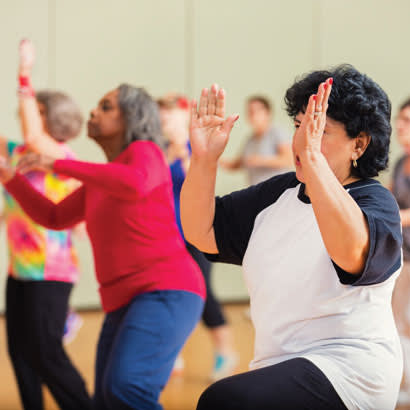
Seniors are the fastest-growing population in the United States. In fact, by 2030, one in five Americans will be at least 65 years old. This explosive population growth has created a tremendous demand for unique health and fitness services to meet the needs of older adults. Regular physical activity contributes to the prevention and management of chronic diseases, as well as a host of other health issues older adults face. It also has been shown to reduce the risk of falling and bone fractures as people age, can help prevent or lessen a variety of physical limitations, stave off depression and improve mental well-being, and can significantly help older adults maintain their independence and enjoy daily life.
As baby boomers age, they are not ready to accept the “senior status” label as quickly as previous generations. While the traditional definition of “seniors” includes everyone aged 65 and older, many baby boomers in their mid-to-late 60s reject the label and don’t want to be treated as such. Baby boomers look forward to active, mobile and productive years in the later decades of life. This younger mindset of older adults is requiring recreation and park departments to get creative with their fitness programming. In days of yore, “senior fitness” classes often took place at “senior centers” and were often a bit more passive than what many older adults are looking for today. Following are some thoughts to help you develop older adult fitness programming that is safe, fun and effective.
Branded Group Exercise Classes
Branded classes (think Jazzercise; BodyPump, Zumba) have been around for many years and are offered by many recreation departments. However, in recent years, there has been a significant increase in both the number and variety of classes available. These classes often develop legions of fans, and as a result, the companies develop multiple spinoffs. Traditionally, many of these branded classes did not include programming designed for older adults, but there is evidence that this is changing.
For example, Zumba has been wildly popular among a variety of populations and is offered far and wide. One of Zumba’s latest offerings, Zumba Gold, was designed to be a low-intensity workout, specifically for older adults. And, the research suggests that Zumba Gold is effective. The American Council on Exercise (ACE) conducted a small independent research study to determine whether Zumba Gold meets current guidelines for improving and maintaining cardiorespiratory fitness. This study found that participation did fulfill the exercise intensity guidelines. Perhaps most importantly, the participants in the study enjoyed the experience of Zumba Gold, which suggests that they are likely to continue attending classes.
Given this information, Zumba Gold might be an ideal exercise program to add to your menu for middle-aged and older adults. Read more about the Zumba study.
Hire Well-Qualified Exercise Professionals
One of the key elements to offering safe and effective fitness programming for older adults is to make sure you hire individuals who have the proper expertise. The “gold standard” in fitness credentialing is the National Commission for Certifying Agencies (NCCA). One of the qualities you should be looking for when hiring group exercise instructors is a certification that is accredited by the NCCA. When offering branded programming, you will also need to ensure that your instructors have the proper credentials to offer that particular brand.
In addition to basic group fitness certifications, you may also want to look for additional training that specializes in working with older adults. Several well-respected organizations certifying exercise professionals offer these under different names. ACE offers a Senior Fitness Specialist program that educates fitness professionals about the unique challenges of working with older adults, and teaches modifications and progressions for guiding them through fitness routines that will help them prevent muscle deterioration, improve balance and bone strength, and boost quality of life.
Choose the Setting with Care
One of the best parts about group exercise classes is that you have a lot of flexibility around where to offer them. Don’t fret if you don’t have a gym! If you are in a mild climate, consider outside on grass. You would want to ensure that the area is flat and relatively free of obstacles, such as tree limbs, rocks, etc. Community centers or other indoor recreation facilities might well accommodate group exercise classes, depending on the flooring and space — the fitness area should be appropriate and safe for whatever class you are offering.
If you don’t have appropriate space at your facilities, consider partnering with other organizations around town to offer classes. Is there a corporate campus in town that might have a gym or classroom and be willing to allow you to run some community classes during non-peak times as part of its corporate social responsibility efforts? Are there faith-based facilities that might be interested in partnering with your department and offering some programming at their facility? One word of caution: don’t be tempted to only offer “older adult programming” at the senior center. With the determined, youthful mindset of today’s older Americans, “fitness for old people” may experience less than ideal registration numbers. You may find that a slate of classes full of older adults will require a variety of programming for sustaining vibrant lifestyles well into the golden years.
Sheila Franklin is the Director of Government Relations for the American Council on Exercise and a former Park and Recreation Professional, having worked for both the Wheaton Park District in Wheaton, Illinois, and the Maryland Recreation and Parks Association.

